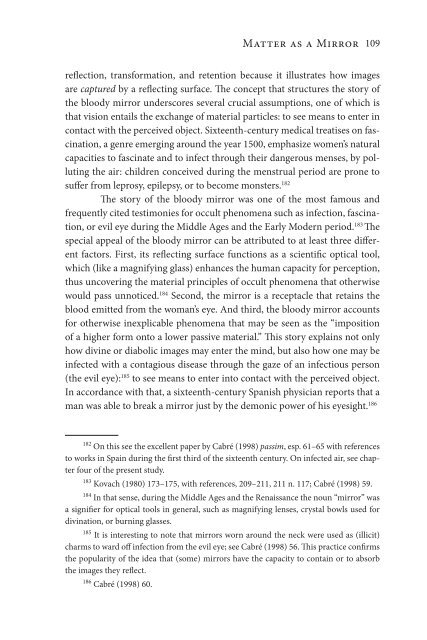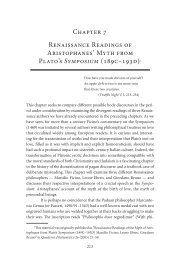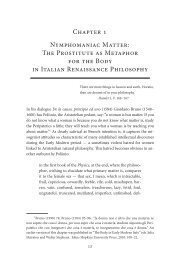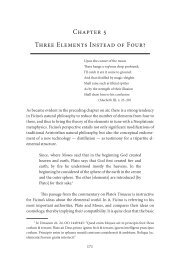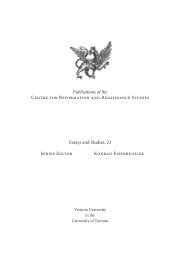Chapter 2 Matter as a Mirror: Marsilio Ficino and Renaissance ...
Chapter 2 Matter as a Mirror: Marsilio Ficino and Renaissance ...
Chapter 2 Matter as a Mirror: Marsilio Ficino and Renaissance ...
You also want an ePaper? Increase the reach of your titles
YUMPU automatically turns print PDFs into web optimized ePapers that Google loves.
<strong>Matter</strong> <strong>as</strong> a <strong>Mirror</strong> 109<br />
reflection, transformation, <strong>and</strong> retention because it illustrates how images<br />
are captured by a reflecting surface. The concept that structures the story of<br />
the bloody mirror underscores several crucial <strong>as</strong>sumptions, one of which is<br />
that vision entails the exchange of material particles: to see means to enter in<br />
contact with the perceived object. Sixteenth-century medical treatises on f<strong>as</strong>cination,<br />
a genre emerging around the year 1500, emph<strong>as</strong>ize women’s natural<br />
capacities to f<strong>as</strong>cinate <strong>and</strong> to infect through their dangerous menses, by polluting<br />
the air: children conceived during the menstrual period are prone to<br />
suffer from leprosy, epilepsy, or to become monsters. 182<br />
The story of the bloody mirror w<strong>as</strong> one of the most famous <strong>and</strong><br />
frequently cited testimonies for occult phenomena such <strong>as</strong> infection, f<strong>as</strong>cination,<br />
or evil eye during the Middle Ages <strong>and</strong> the Early Modern period. 183 The<br />
special appeal of the bloody mirror can be attributed to at le<strong>as</strong>t three different<br />
factors. First, its reflecting surface functions <strong>as</strong> a scientific optical tool,<br />
which (like a magnifying gl<strong>as</strong>s) enhances the human capacity for perception,<br />
thus uncovering the material principles of occult phenomena that otherwise<br />
would p<strong>as</strong>s unnoticed. 184 Second, the mirror is a receptacle that retains the<br />
blood emitted from the woman’s eye. And third, the bloody mirror accounts<br />
for otherwise inexplicable phenomena that may be seen <strong>as</strong> the “imposition<br />
of a higher form onto a lower p<strong>as</strong>sive material.” This story explains not only<br />
how divine or diabolic images may enter the mind, but also how one may be<br />
infected with a contagious dise<strong>as</strong>e through the gaze of an infectious person<br />
(the evil eye): 185 to see means to enter into contact with the perceived object.<br />
In accordance with that, a sixteenth-century Spanish physician reports that a<br />
man w<strong>as</strong> able to break a mirror just by the demonic power of his eyesight. 186<br />
182 On this see the excellent paper by Cabré (1998) p<strong>as</strong>sim, esp. 61–65 with references<br />
to works in Spain during the first third of the sixteenth century. On infected air, see chapter<br />
four of the present study.<br />
183 Kovach (1980) 173–175, with references, 209–211, 211 n. 117; Cabré (1998) 59.<br />
184 In that sense, during the Middle Ages <strong>and</strong> the <strong>Renaissance</strong> the noun “mirror” w<strong>as</strong><br />
a signifier for optical tools in general, such <strong>as</strong> magnifying lenses, crystal bowls used for<br />
divination, or burning gl<strong>as</strong>ses.<br />
185 It is interesting to note that mirrors worn around the neck were used <strong>as</strong> (illicit)<br />
charms to ward off infection from the evil eye; see Cabré (1998) 56. This practice confirms<br />
the popularity of the idea that (some) mirrors have the capacity to contain or to absorb<br />
the images they reflect.<br />
186 Cabré (1998) 60.


